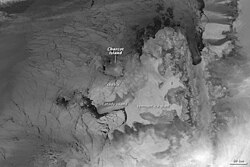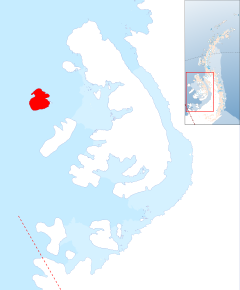Charcot Island
| Charcot Island | |
 Satellite picture of Charcot and neighbours | |
|---|---|
| Location | |
| Location: | 69°57’10"S, 75°10’18"W |
| Area: | 995 square miles |
| Data | |
| Population: | Uninhabited |
Charcot Island is an island within the British Antarctic Territory 30 nautical miles long and 25 nautical miles wide, within the Bellingshausen Sea, 55 nautical miles west of Alexander Island, and about 31 nautical miles north of Latady Island.
The island is ice covered except for prominent mountains overlooking the north coast. A notable landmark of the island is its northernmost point, Cape Byrd.
History
Charcot Island was discovered on 11 January 1910 by the French Antarctic Expedition under Jean-Baptiste Charcot, who, at the insistence of his crew and the recommendation of Edwin S. Balch and others, named it Charcot Land. He did so with the stated intention of honouring his father, Jean-Martin Charcot, a famous French physician.[1] It was discovered to be an island by Sir Hubert Wilkins, who flew around Charcot Land on 29 December 1929.
2009 Collapse of ice bridge
The ice bridge holding the Wilkins Ice Shelf to the Antarctic coastline and Charcot Island was 25 miles long but only 500 yards wide at its narrowest point – in 1950 it was 62 miles. The ice bridge shattered in April 2009 over an area measuring 12½ miles by 1½ miles. The ice bridge collapsed rapidly, turning into hundreds of icebergs.[2]
References
- ↑ 'Exploring Polar Frontiers: A Historical Encyclopedia, Volume 2': Charcot Island (Antarctic Peninsula)
- ↑ Smith, Lewis (April 6, 2009). "Breakaway ice shelf will reshape map of Antarctica". London: Times Online. http://www.timesonline.co.uk/tol/news/environment/article6041360.ece. Retrieved April 6, 2009.
- Gazetteer and Map of The British Antarctic Territory: Charcot Island
